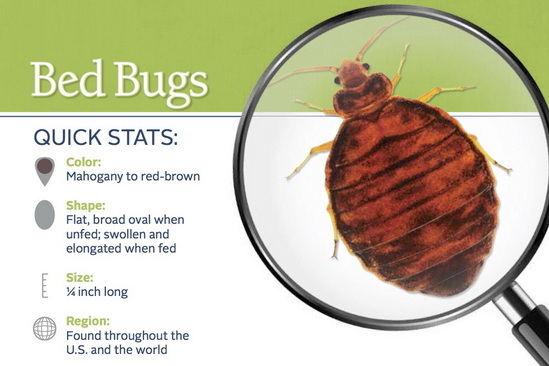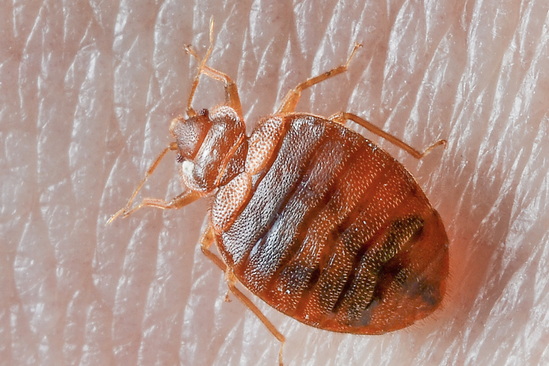
Bedbug Info
Bed bugs get their name from their habit of taking refuge in beds and feeding on humans while they sleep. Bed bugs feed only on blood and must have regular blood meals to survive and develop. Humans are not their only target, they also will attack many warm-blooded animals, including poultry and other birds. Bed bugs have been associated with humans for more than 3,300 years and are found in virtually every place people tend to gather, including residences, hotels, schools, offices, retail stores and even public transportation.
Bed bugs are great hitchhikers, allowing them to travel long distances. They latch onto suitcases, clothes, and linens and can end up wherever these items are taken. This is why the spread of bed bugs occurs so easily. Furthermore, it’s often hard to identify bed bug bites and they can easily be confused with bites from a different pest, making infestations difficult to detect and allowing populations to grow unnoticed.
Perhaps the most alarming feature of bed bugs is their fast-reproductive nature. Females lay 1-5 eggs per day, reaching up to 541 eggs in their lifetime. It only takes about 21 days for these nymphs to become adult bed bugs. If a bed bug population goes undetected, these bugs can quickly infest an entire household or building. Once established, an infestation can be extremely difficult to get rid of.


Bed bugs are extremely elusive creatures so professional help should be sought out when dealing with an infestation. Bed bugs are a very difficult pest to treat. If you suspect or discover an infestation, contact us to address the issue.
Bedbug ID
Bed bugs are secretive creatures and it’s not uncommon to have a severe infestation without ever seeing an actual bed bug. Often the only way to know you have bed bugs is if you wake up with bite symptoms you didn’t have when you went to sleep. The bites can become red, itchy and swollen, and they tend to be found in a pattern or in small clusters. This is an indication that the bites are from bed bugs and not a different pest. You can often find droppings (dried blood flakes) in the cracks and crevices around your sleeping area. Some places that you should check to confirm an infestation include:
- Inside electrical switch plates, picture frames, and wallpaper.
- Behind baseboards, around mattress buttons, within bedding and inside box springs.
- Inside and behind cracks and crevices in walls or wood.
- Behind a fixed headboard.
where do bed bugs come from?
Bed bugs are a common pest that can be found in any location where humans congregate. Infestations are rarely caused by any hygiene issue and correlate much more strongly towards population density. For instance, the fact that hotels often have different people staying in the same room night after night makes it much more likely that they would experience a bed bug infestation. They are difficult to see and can easily travel from one place to another. To prevent bed bugs from entering your home, be on the lookout for signs of bed bugs when using public transportation or sitting in public spaces. When traveling, thoroughly inspect hotel rooms before sleeping in the bed. Look for bed bugs, their eggs, or fecal matter. If you see any signs of bed bugs, ask the hotel staff to move you to another room. When you return home, vacuum your suitcase and inspect it for bed bugs. Wash your clothes on hot cycles, even those that you did not wear. Do not bring second-hand furniture into your home without thoroughly inspecting it for bed bugs. Remember that bed bugs can fit into spaces about the width of a credit card. This means they can get just about anywhere so long as there’s blood to feed on. If you are not sure how to inspect for bed bugs, you may want to have a pest control professional inspect the furniture for you.
Bed bugs can be found al. over the world, and the earliest concrete evidence of a bed bug infestation dates back to 1500 BC! Control was firmly established by the middle part of the 20th century, but there has been a sharp increase in the number of bed bug sightings since the 1990’s. The exact cause of this increase is unknown; theories include increased human travel, more frequent exchange of second-hand furnishings, a greater focus on control of other pests, and increasing resistance to pesticides.
- Bed bugs like to hide in dark, secluded places, so it is important to keep your home clean and free of clutter. This will make it more difficult for bed bugs to find a place to hide.
- Seal up any cracks and crevices in your home. Bed bugs can enter your home through even the smallest cracks and crevices. To prevent bed bugs from entering your home, seal up any cracks and crevices with caulk or weatherstripping.
- Inspect your belongings for bed bugs before bringing them into your home. If you are bringing belongings into your home from another location, be sure to inspect them for signs of bed bugs. This includes checking suitcases, furniture, and other items.
- By following these tips, you can help to prevent bed bugs from entering your home.
The National Pest Management Association’s 2018 Bugs Without Borders Research confirmed that bed bugs can be found nearly anywhere. Most commonly single-family homes (91 percent), apartments/condominiums (89 percent) and hotels/motels (68 percent). In addition to these most common places where you might expect to find them, they were also found in places one might not expect, including nursing homes (59 percent), schools and daycare centers (47 percent), office buildings (46 percent), college dorms (45 percent), hospitals (36 percent) and public transportation (19 percent). It is important to know how to identify the tell-tale signs of bed bugs whenever spending time in a populated area.
Bed bugs usually come out at night to eat, while you’re sleeping in your bed. However, they are opportunistic feeders and will take a blood meal during the day if given an opportunity, especially in very heavily infested areas. Bed bugs usually require 5-10 minutes to engorge with blood. After feeding, they move to secluded places and congregate for several days until they are ready to feed again. During this time in the bed bug life cycle, they digest their meal, mate, and lay eggs. It is possible for adult bed bugs to go several months without a blood meal. They also can withstand temperatures from nearly freezing up to 122 degrees Fahrenheit, allowing them to survive in harsh conditions.
Because their bites are nearly painless, humans usually don’t notice or wake up when bitten. Bed bugs do not transmit disease and unless one is allergic do not require professional treatment. People who experience severe itching usually can find relief with over-the-counter topical steroid creams.
Why Choose Our Services ?
Our technicians are licensed, insured, bonded, and highly qualified to deal with any problem in your home or business. We will restore your home to a clean, sanitary, and safe living environment and help you maintain that condition. We’ve been providing pest control services in the Columbia area for over 40 years, and our iron-clad guarantee means that relief from noxious pests is never more than a phone call away. Contact us today!
Bed bugs. (2023, May 16). In Pest World. Retrieved from https://www.pestworld.org/pest-guide/bed-bugs/bed-bugs/
Bed bug. (2023, May 16). In Wikipedia, The Free Encyclopedia. Retrieved from https://en.wikipedia.org/wiki/Bed_bug